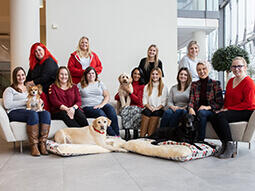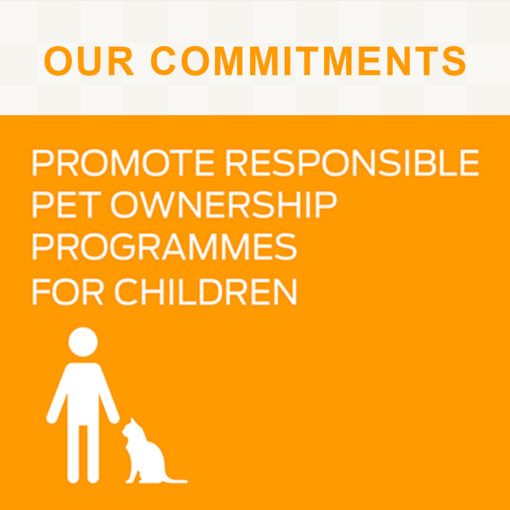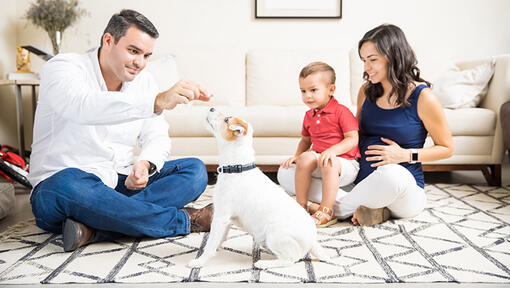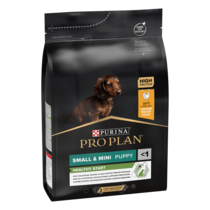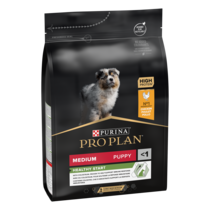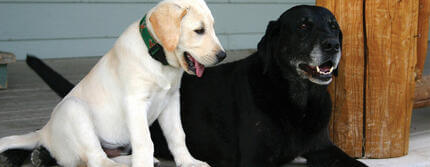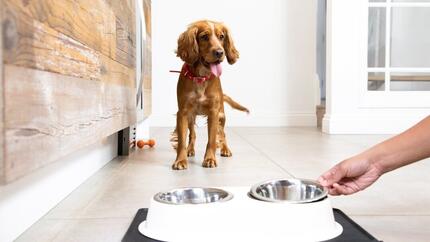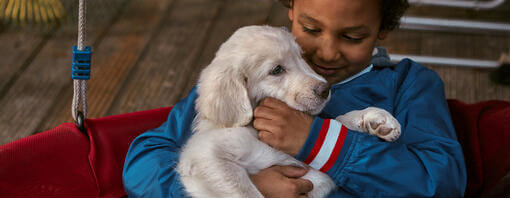

Puppies and children can have a loving relationship when introductions are done right. Find out how to get their relationship off to a flying start.
Just like our children, our dogs are part of our families. It’s only natural that we want them to get on and become lifelong friends, but getting them to that stage can be tricky. If you’ve recently got a new puppy or had a new baby, you may be wondering about dogs and children and how to begin the relationship. At Purina, we’ve put together this useful guide that tells you how to introduce a dog to a baby or child and the first steps you should take to create the building blocks for a loving, understanding friendship.
Introducing dogs and children
If you’re expecting a new puppy and have a young child, you’ll need to educate them how to approach dogs with care and respect their boundaries. Put yourself in your dog’s shoes – children are small, make sudden movements and are known to make high pitched noises, all of which are things that will intimidate and frighten a dog.
Additionally, because puppies look cute and cuddly, children will often associate them with soft toys or teddy bears and are likely to treat them as such. So if they’re not taught from the start to be gentle, they’ll probably squeeze and chase them.
Another factor to consider is that when children are very young, they don’t have the social skills to identify when a puppy is scared or uncomfortable. They’ll also struggle to identify dog’s body language and won’t understand when they’re being aggressive or telling them to back off. You should explain to your child that you should never poke, squeeze or pull at your dog and only use quiet voices when around them. It’s also a good idea to tell them never to wake a sleeping pup as this may cause them to snap. If you need more information on educating your child on dog ownership, take a look at Purina Pet school, an interactive tool for teaching the pet owners of tomorrow.
Preparation
By setting some basic house rules, as a family, before your new puppy or dog arrives, you will help your children to understand what’s expected of them. Just as you will do with your puppy or dog, you’ll be teaching your children what you would like them to do.
- Rather than ‘no shouting around the dog’ the rule could be ‘quiet voices only around the dog’, or, as teacher’s say; ‘indoor voices only’ around the dog!
- Rather than, ‘never poke, squeeze or pull at your dog’ the rule could be ‘gently stroke the dog, only when s/he comes to you’ so that the child beings to respect the dog’s boundaries. If they’re taught to only stroke the dog when the dog comes to them and that they stop when the dog moves away, the dog will quickly learn to trust them.
- Rather than ‘never wake a sleeping puppy’ the rule could be, ‘when the dog is asleep, it’s time for us to do…’ and then list some of your child’s favourite activities. Having a safe space for your dog to retreat to is vital and teaching your children that it’s a no-go area when your dog is asleep is also vital. However, telling your children it’s a ‘no-go area’ makes it even more enticing, so give them a fun alternative.
You can practice all of these rules before the new puppy or dog arrives so that you’re prepared. Your new friend will thank you for it.
Steps to introduce puppies and children
Whether you’re bringing a puppy or an older dog home, you will have had the opportunity to meet them and spend time with them first, whether that’s at the breeder’s home or through the rescue centre.
These introductions will help your new friend to learn that you’re kind and can be trusted; the basis for any successful relationship. Remember that the aim is to encourage a calm and gentle approach and to help with that, make sure that your child isn’t carrying their favourite toy or eating anything during this meeting. If possible, have two adults present, so that one can focus on the dog and one on the child. If you have multiple children, it can be less overwhelming for everyone, especially the dog, if the introductions are phased with one or two children at a time.
The best way to introduce puppies and children are as follows:
- Get your child to calmly approach from the side, then allow your puppy to come the rest of the way. This will enable your dog to meet them on their own terms.
- Once the puppy is close enough, tell your child to offer a closed fist for your dog to sniff – a closed fist eliminates the possibly of nipped fingers.
- When your dog is comfortable, ask your child to gently stroke their head and neck, avoiding sensitive areas like the ears, tail, feet and stomach.
Sometimes it’s a good idea to introduce dogs and children outside, so your pup doesn’t feel trapped. Alternatively, if you’re introducing at home, choose a large room with a relaxed atmosphere that will allow your dog plenty of space to run away if they want to. Don’t give treats or toys during the first meeting either, your dog may get excited and snatch, which may frighten your child and get the relationship off on the wrong foot.
Benefits of looking after a dog
There are so many benefits to dog ownership and looking after one can have lifelong advantages for your child and can teach many valuable lessons. Some of the key benefits are:
- Looking after a puppy helps children learn responsibility.
- Caring for dogs increases empathy and helps your child to understand the cycle of life.
- Having a puppy also provides plenty of opportunities for exercise and fun.
The golden rule
Never leave a puppy or dog and a child alone together; regardless of how tolerant your dog is and how well your child has adapted to the house rules. You might not know if your dog is in pain and therefore has a lower tolerance to the noises they’re normally used to. Your child could accidentally fall over onto the dog and frighten them. We all have off days and for the safety of your child and your dog, their relationship needs to develop under supervision, rewarding calm and gentle interactions on both sides.
That’s our guide for introducing dogs or puppies and children. Do you have a new baby on the way and are wondering how to introduce an existing dog or new puppy into the mix? Take a look at our article on introducing dogs and babies, next.
